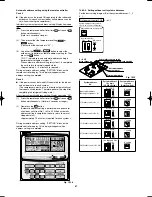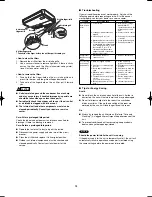
62
10-22-3. Checking indoor unit addresses
Use the remote controller to check the addresses of the indoor
units. Press and hold the
button and
button for 4
seconds or longer (simple settings mode, “ALL” appears on the
remote controller). Then press the
button and select the
indoor address.
(For the system addresses of the No. 1 outdoor unit, each time
the button is pressed, the address changes as follows: 1-1, 1-2,
...)
The indoor unit fan operates only at the selected indoor unit.
Confirm the indoor unit address. (For the system addresses of
the No. 2 outdoor unit, the displayed addresses are 2-1, 2-2, ...)
Press the
button again to return to the normal remote
controller mode.
Fig. 10-20
10-22-4. Indicating (marking) the indoor and outdoor unit
combination number
Indicate (mark) the number after automatic address setting is
completed.
(1) So that the combination of each indoor unit can be easily
checked when multiple units are installed, ensure that
the indoor and outdoor unit numbers correspond to the
system address number on the outdoor unit control PCB,
and use a magic marker or similar means which cannot
be easily removed to indicate the numbers in an easily
visible location on the indoor units (near the indoor unit
nameplates).
Example: (Outdoor) 1 – (Indoor) 1, 2...
(Outdoor) 2 – (Indoor) 1, 2...
(2) These numbers will be needed for maintenance. Be sure to
indicate them.
■
HW Type (for Link Wiring)
10-23. Caution
●
This unit may be used in a single-type refrigerant
system where 1 outdoor unit is connected to 1 indoor
unit, and also in a system where 1 outdoor unit is
connected to multiple indoor units (maximum 4).
●
If link wiring is used, set the outdoor unit system address
to allow the combination of indoor and outdoor units to be
identified. At the same time, indicate the indoor-outdoor unit
combination number in a location where it can be checked
easily (near the indoor unit nameplates). (This number will
be required for subsequent maintenance. Refer to 10-26-3,
-4.)
●
Request that the customer be present when the test run is
performed. At this time, explain the operation manual and
have the customer perform the actual steps.
●
Be sure to pass the manuals and warranty certificate to the
customer.
●
Check that the 220 – 240 V AC wiring is not connected to the
inter-unit control wiring connector terminal.
If 220 – 240 V AC is accidentally applied, the indoor or
outdoor unit control PCB fuse (0.5 A for both indoor and
outdoor units) will blow in order to protect the PCB. Correct
the wiring connections, then disconnect the 2P connectors
(indoor: blue, OC) (outdoor: blue, serial 1) that are
connected to the PCB, and replace them with 2P connectors
(indoor: brown, EMG) (outdoor: brown, serial 2).
If operation is still not possible after changing the brown
connectors, try cutting the varistor (black) (both indoor and
outdoor).
(Be sure to turn the power OFF before performing this work.)
Indoor unit control PCB
Varistor (black)
VA002
Fuse (0.5A)
CHK (2P plug)
SW103
2P connector (brown)
2P connector (blue)
ON
OFF
TEST
2 HP
TEST
ON
OFF
3 HP
Fuse (0.5A)
2P connector (blue)
2P connector (brown)
SW103
Varistor (black)
VA002
CHK (2P plug)
Fig. 10-21
Outdoor unit control PCB
Varistor (black)
VA002
Serial 2 (brown) connector
Serial 1 (blue) connector
Terminal plug (black)
Fuse
0.5 A
3 – 6 HP
Outdoor unit control PCB
Varistor (black)
VA002
Serial 2 (brown) connector
Serial 1 (blue) connector
Terminal plug (black)
Fuse
0.5 A
3 – 6 HP
Airwell̲PAC-i̲eng.indb 62
Airwell̲PAC-i̲eng.indb 62
2009/07/09 16:13:44
2009/07/09 16:13:44
Summary of Contents for OU-PSINV-25HR
Page 75: ...75 ...















































